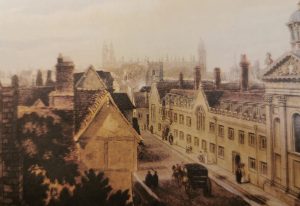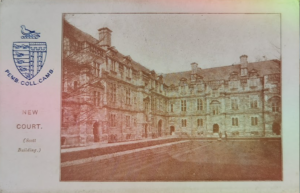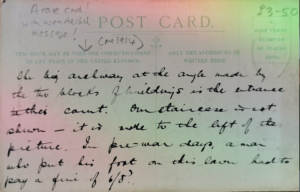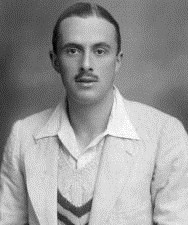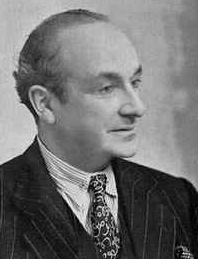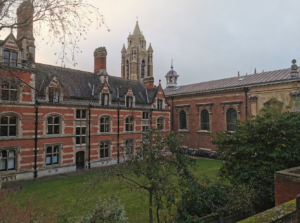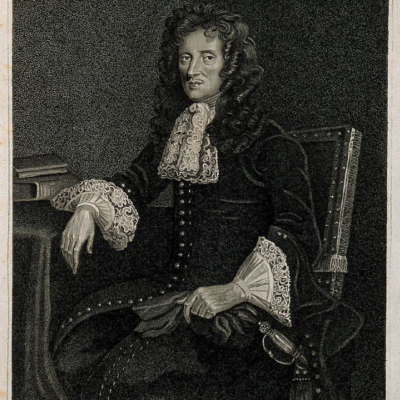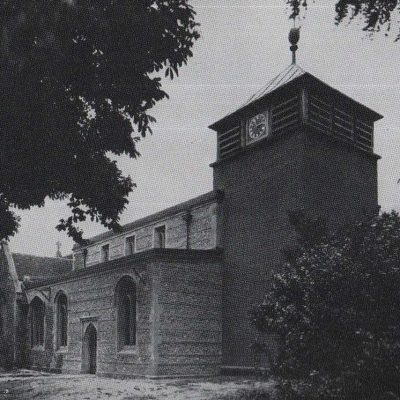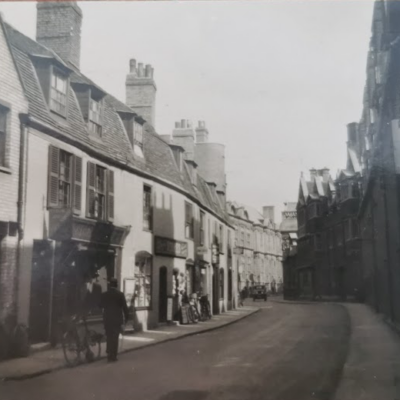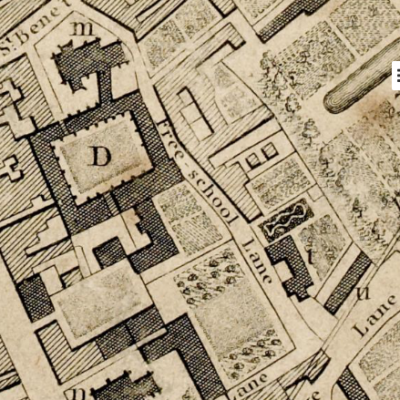Search by topic
- archaeology
- Building of Local Interest
- charity
- church
- crime
- dressmaker
- fire
- Great Eastern Railway
- Listed building
- Mapping Relief
- medieval
- oral history
- poverty
- Public House
- Rattee & Kett
- Religious House
- Roman
- scholar
- school
- Then and Now
- tudor
- women
- work
- world war one
- world war two
Search by text
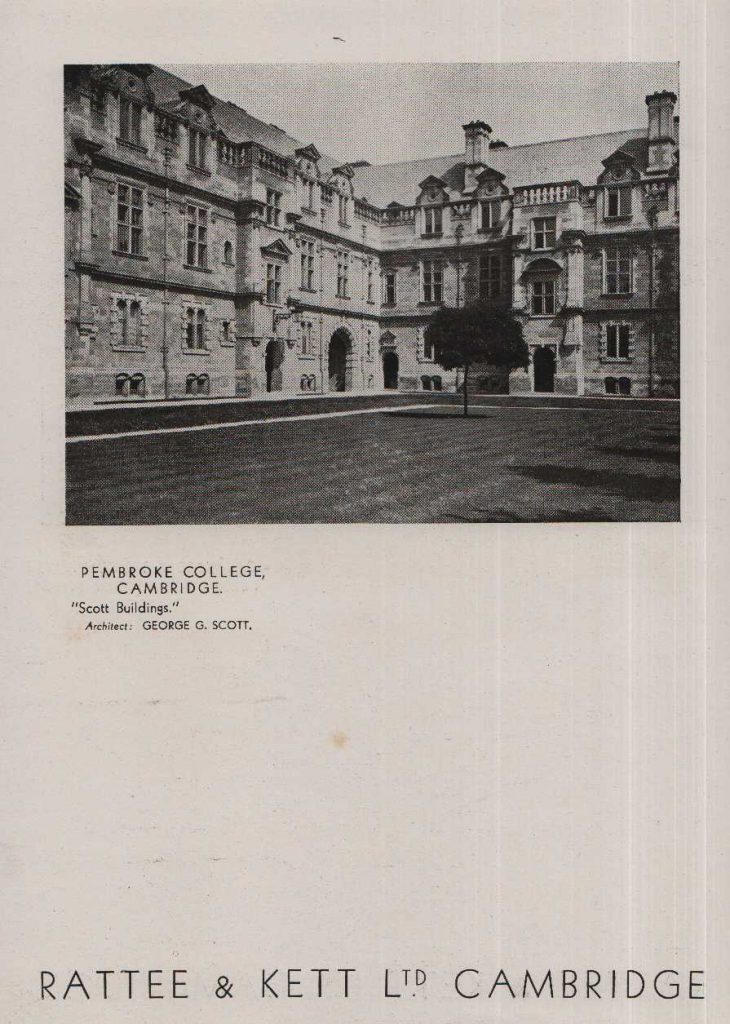
Hall of Valence Marie / Pembroke College
History of Pembroke College
Mary de St Pol, Countess of Pembroke, purchased, in 1346, Stanton House, from Hervey de Stanton, rector of Elm; the house stood on the corner of Trumpington Street and Pembroke Street, formerly called ‘Plot and Nuts Lane.’
The Hall of Valence Marie or Pembroke Hall, now Pembroke College, was founded by Mary de St. Pol, Countess of Pembroke, Baroness of Wexford in Ireland, and of Montignac, Bellac and Rançon in France, daughter of Guy, Count of St. Pol, and widow of Aymer de Valence, Earl of Pembroke. The Royal Licence of foundation was granted by Edward III on 24 December 1347.
1351 University Hostel added
1363 two strips of land purchased as a garden. These survive as the bowling green and orchards in the Fellows’ garden.
1665 a new chapel was built at the expense of Matthew Wren, Bishop of Ely (1638-1667). During the Civil War he had been kept prisoner in the Tower of London. During 17 years imprisonment he vowed to build a new chapel at Pembroke if he were released.
1871 census:
Henry M D Ratcliffe, 20, undergraduate, b Kent
Thomas Smith, 65, college butler, b Lancs
Elizabeth Hodson, sister to above, widow, butler’s housekeeper, b Lancs
John Hodson, son to above, 31, butler’s assistant, b Liverpool
Simeon Hayward, 22, butler’s servant, b Cambridge
Emmeline Peters, 17, butler’s servant, b Trumpington
Theodore R Stockley, 37 college under porter, b Cambridge
For more information about Thomas Smith and his legacy to his nephew John Hodson.
General information about Pembroke College can be found on Wikipedia.
In 1878 it had been proposed to demolish the ‘Old Library’ at Pembroke College but the Fellows had the task of renovation handed over to George Gilbert Scott Jnr. As a result the Old Libary was saved and Scott designed New Court which was built by Rattee and Kett in 1881. The New Court combines elements of the Arts and Crafts movement with motifs from over three centuries of architecture.
For more information see:
http://www.pem.cam.ac.uk/the-college/pembroke-past-and-present/
The chapel was designed by Christopher Wren, his very first engagement as an architect in fact:
http://www.pem.cam.ac.uk/the-college/pembroke-past-and-present/chapel/
The big archway at the angle made by the two block of buildings is the entrance to this court. Our staircase is not shown – it is more to the left of the picture. In pre-war days, a man who put his foot on this lawn had to pay a fine of 6/8?
1918
Death of Captain Peyton Sheldon Hadley, elder son of Master of Pembroke. Serving with Northants Regiment, he was awarded the MC in June 1916. He died 25th October 1918 of pneumonia and influenza aged 23.
The first son of William Sheldon Hadley (Master of Pembroke College, Cambridge) and Edith, his wife, of The Master’s Lodge, Pembroke College, and Heacham, Norfolk. Named Isaac Peyton Sheldon. He was at Charterhouse School between 1909 – 1914. He won a place at Pembroke College, Cambridge but shortly after the declaration of war took a commission in the Northamptonshire Regiment, joining 7th Battlion. This was a sportsman’s battalion raised by the Northampton Rugby international Edgar Mobbs, who was later himself Battalion Commander and died at Passchendaele. He won the M.C. In the autumn of 1918 he was seriously wounded and was invalided home to the Central Military Hospital, Eastbourne. Here on 25th October 1918 he died of pandemic influenza. His grave is in the north-east part of St. Mary’s churchyard, Heacham North Norfolk. He lies under a private stone, bearing inset in bronze the cross of sacrifice and the military cross. His parents are buried next to him. His younger brother was the composer Patrick Hadley, who was also wounded in the closing weeks of the war, losing a leg, but survived. (https://www.surreyinthegreatwar.org.uk/person/114214)
Contribute
Do you have any information about the people or places in this article? If so, then please let us know using the Contact page or by emailing capturingcambridge@
License
This work is licensed under CC BY-NC-SA 4.0





